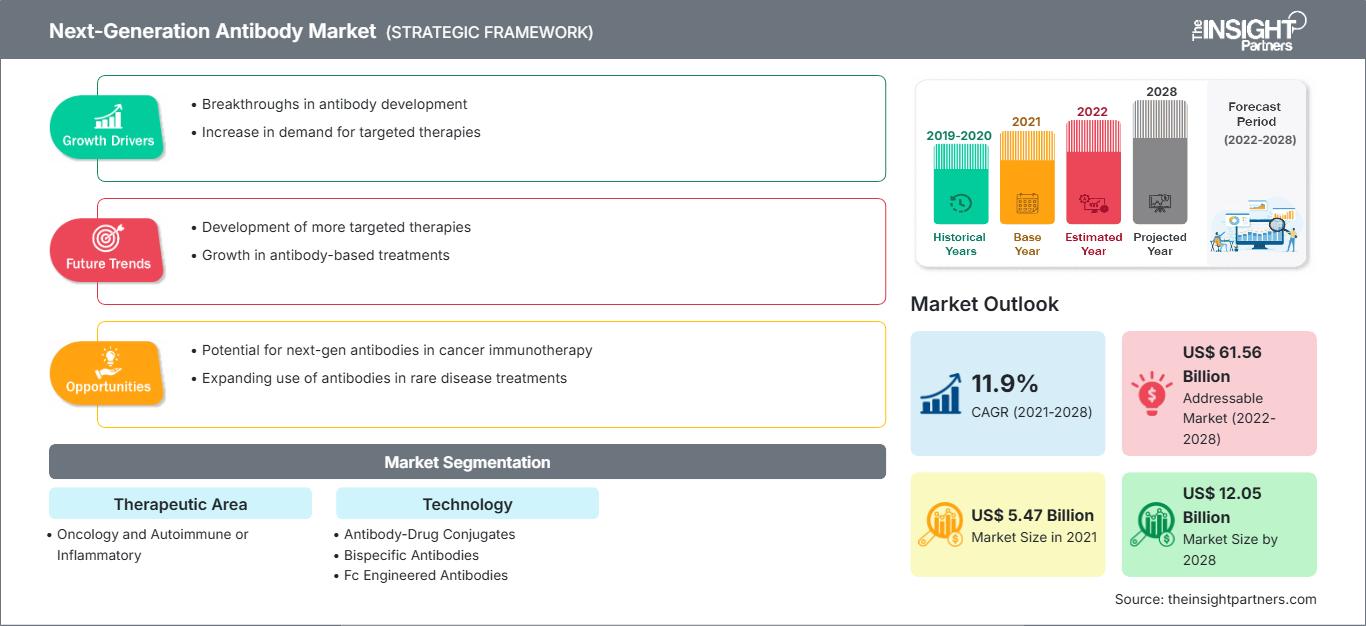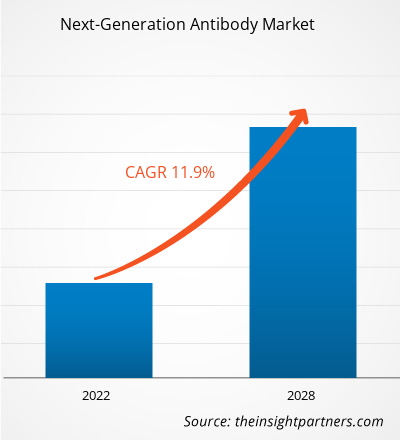Le marché des anticorps de nouvelle génération devrait atteindre 12 050,13 millions de dollars américains d'ici 2028, contre 5 468,41 millions de dollars américains en 2021 ; sa croissance est estimée à un TCAC de 11,9 % entre 2021 et 2028.
Les anticorps de nouvelle génération sont conçus pour être plus spécifiques et souvent plus puissants que les anticorps monoclonaux traditionnels. Des stratégies d'anticorps de nouvelle génération sont nécessaires pour concevoir une thérapie efficace combinant anticorps, charge utile, lieur et méthode de conjugaison, tout en garantissant la stabilité, une administration ciblée et des effets hors cible limités.
Le rapport offre des informations et une analyse approfondie du marché des anticorps de nouvelle génération, en mettant l'accent sur divers paramètres tels que les tendances du marché, les avancées technologiques, la dynamique du marché et l'analyse du paysage concurrentiel des principaux acteurs mondiaux. Il inclut également l'impact de la pandémie de COVID-19 sur le marché dans toutes les régions. La pandémie a perturbé les conditions socio-économiques de divers pays à travers le monde. Actuellement, les États-Unis sont le pays le plus touché au monde par l'épidémie de COVID-19, avec le plus grand nombre de cas confirmés et de décès au monde, selon les dernières statistiques de l'OMS. Le nombre élevé de cas positifs de COVID-19 a eu un impact négatif sur les économies mondiales. On a constaté un déclin de l'activité économique globale et une baisse de la croissance de divers secteurs d'activité à l'échelle mondiale.
Vous bénéficierez d’une personnalisation sur n’importe quel rapport - gratuitement - y compris des parties de ce rapport, ou une analyse au niveau du pays, un pack de données Excel, ainsi que de profiter d’offres exceptionnelles et de réductions pour les start-ups et les universités
Marché des anticorps de nouvelle génération: Perspectives stratégiques

- Obtenez les principales tendances clés du marché de ce rapport.Cet échantillon GRATUIT comprendra une analyse de données, allant des tendances du marché aux estimations et prévisions.
L'épidémie de COVID-19 a lourdement pesé sur les infrastructures de santé aux États-Unis, au Canada et au Mexique. De plus, la plupart des entreprises pharmaceutiques et biotechnologiques ainsi que des instituts de recherche sont engagés dans le développement de vaccins et de médicaments contre la COVID-19. Des sociétés pharmaceutiques établies et de petites start-ups se sont mobilisées pour développer des traitements et des vaccins ciblant l'infection créée par le nouveau coronavirus. Par conséquent, les activités de recherche sur les vaccins au sein des entreprises pharmaceutiques et biotechnologiques, des centres de recherche et des instituts de recherche universitaire sont reconnues comme essentielles et leurs opérations et leur production n'ont pratiquement pas été affectées. Cependant, en raison de l'augmentation des activités de recherche, l'accessibilité au financement des analyses et le besoin d'anticorps, y compris d'anticorps de nouvelle génération, devraient augmenter. De plus, face à l'épidémie de COVID-19, de nombreux chercheurs du monde entier participent à l'analyse virale du SARS-CoV-2, le virus responsable de la COVID-19. Pour les vaccins comme pour les traitements, les anticorps générés sont examinés pour déterminer leur efficacité fonctionnelle à contrebalancer le virus cible. Français Par conséquent, la pandémie de COVID-19 devrait avoir un impact positif sur le marché des anticorps de nouvelle génération dans les années à venir.
En fonction de la région, le marché des anticorps de nouvelle génération est segmenté en Amérique du Nord, Europe, Asie-Pacifique, Moyen-Orient et Afrique, et Amérique du Sud et centrale.
Aperçu du marché
La demande croissante de thérapies par anticorps de nouvelle génération stimulera le marché des anticorps de nouvelle génération
Les développements croissants de la biotechnologie ont conduit à une acceptation croissante des thérapies par anticorps de nouvelle génération, ce qui favorise leur utilisation dans le traitement des maladies auto-immunes, inflammatoires et chroniques. Les traitements par anticorps de nouvelle génération sont le résultat de l'application de technologies sophistiquées dans les thérapies par anticorps, telles que les conjugués anticorps-médicament (ADC), les anticorps glyco-ingéniérés et les anticorps spécifiques (BsAbs). Par conséquent, les applications des anticorps de nouvelle génération sont largement étudiées pour traiter diverses maladies chroniques telles que le cancer, le VIH, les maladies infectieuses, etc. La demande croissante pour ces anticorps a entraîné une augmentation rapide de l'approbation des ADC et d'autres thérapies à base d'anticorps de nouvelle génération. Par exemple, en mai 2020, Takeda Pharmaceutical Company Limited a annoncé l'approbation par la FDA d'ALUNBRIG (brigatinib) pour les patients adultes atteints d'un cancer du poumon non à petites cellules (CPNPC) métastatique à kinase de lymphome anaplasique positive (ALK+) détecté par un test approuvé par la FDA. L'indication actuelle d'ALUNBRIG a été élargie pour inclure le traitement de première intention avec son approbation. ALUNBRIG est un inhibiteur de tyrosine kinase (ITK) de nouvelle génération conçu pour cibler les anomalies moléculaires d'ALK. Français De même, en 2019, Genentech a annoncé l'approbation accélérée par la FDA du Polatuzumab vedotin-piiq, un conjugué anticorps-médicament dirigé contre CD79b indiqué en association avec la bendamustine et un produit à base de rituximab pour les patients adultes atteints d'un lymphome diffus à grandes cellules B récidivant ou réfractaire.
Par conséquent, le marché des anticorps de nouvelle génération devrait connaître une croissance rapide au cours de la période de prévision en raison de l'augmentation des approbations d'essais cliniques et de l'adoption massive de thérapies à base d'anticorps de nouvelle génération pour le traitement de diverses maladies.
Informations basées sur les domaines thérapeutiques
Sur la base des domaines thérapeutiques, le marché des anticorps de nouvelle génération est divisé en oncologie et auto-immune ou inflammatoire. Le segment de l'oncologie représentait une part plus importante du marché.
Informations technologiques
Sur le plan technologique, le marché des anticorps de nouvelle génération est segmenté en conjugués anticorps-médicament, anticorps bispécifiques, anticorps Fc modifiés, fragments d'anticorps et protéines de type anticorps, et anticorps biosimilaires. Le segment des conjugués anticorps-médicament détenait la plus grande part de marché en 2021, et devrait enregistrer le TCAC le plus élevé du marché, soit 12,1 %, au cours de la période de prévision.
Les acteurs du marché des anticorps de nouvelle génération adoptent diverses stratégies organiques, telles que le lancement et l'expansion de produits, pour étendre leur présence et leur portefeuille de produits à l'échelle mondiale et répondre à la demande croissante.
Anticorps de nouvelle générationAperçu régional du marché des anticorps de nouvelle génération
Les tendances régionales et les facteurs influençant le marché des anticorps de nouvelle génération tout au long de la période de prévision ont été analysés en détail par les analystes de The Insight Partners. Cette section aborde également les segments et la géographie du marché des anticorps de nouvelle génération en Amérique du Nord, en Europe, en Asie-Pacifique, au Moyen-Orient et en Afrique, ainsi qu'en Amérique du Sud et en Amérique centrale.
Portée du rapport sur le marché des anticorps de nouvelle génération
| Attribut de rapport | Détails |
|---|---|
| Taille du marché en 2021 | US$ 5.47 Billion |
| Taille du marché par 2028 | US$ 12.05 Billion |
| TCAC mondial (2021 - 2028) | 11.9% |
| Données historiques | 2019-2020 |
| Période de prévision | 2022-2028 |
| Segments couverts |
By Domaine thérapeutique
|
| Régions et pays couverts | Amérique du Nord
|
| Leaders du marché et profils d'entreprises clés |
|
Densité des acteurs du marché des anticorps de nouvelle génération : comprendre son impact sur la dynamique des entreprises
Le marché des anticorps de nouvelle génération connaît une croissance rapide, porté par une demande croissante des utilisateurs finaux, due à des facteurs tels que l'évolution des préférences des consommateurs, les avancées technologiques et une meilleure connaissance des avantages du produit. Face à cette demande croissante, les entreprises élargissent leur offre, innovent pour répondre aux besoins des consommateurs et capitalisent sur les nouvelles tendances, ce qui alimente la croissance du marché.

- Obtenez le Marché des anticorps de nouvelle génération Aperçu des principaux acteurs clés
- Analyse historique (2 ans), année de base, prévision (7 ans) avec TCAC
- Analyse PEST et SWOT
- Taille du marché Valeur / Volume - Mondial, Régional, Pays
- Industrie et paysage concurrentiel
- Ensemble de données Excel
Rapports récents
Témoignages
Raison d'acheter
- Prise de décision éclairée
- Compréhension de la dynamique du marché
- Analyse concurrentielle
- Connaissances clients
- Prévisions de marché
- Atténuation des risques
- Planification stratégique
- Justification des investissements
- Identification des marchés émergents
- Amélioration des stratégies marketing
- Amélioration de l'efficacité opérationnelle
- Alignement sur les tendances réglementaires




















 Obtenez un échantillon gratuit pour - Marché des anticorps de nouvelle génération
Obtenez un échantillon gratuit pour - Marché des anticorps de nouvelle génération